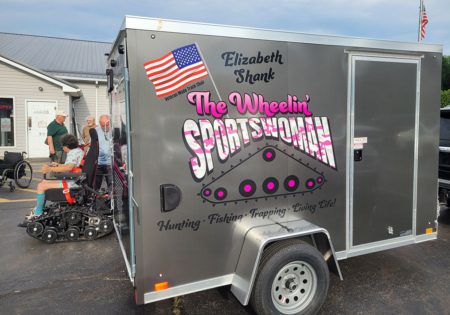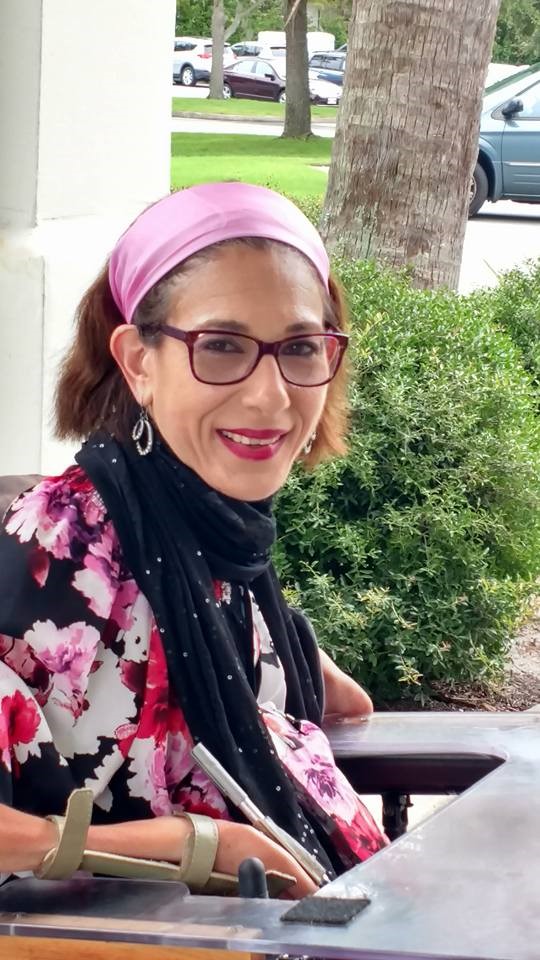By Ed Pfueller, UOAA Communications and Outreach Manager
Elizabeth Shank was paralyzed in an accident at the age of 20 and has had an ostomy for the past year. She continues to embrace the things she loves most.
Shank, 50, became an outdoors enthusiast during her life with a wheelchair. For almost a decade, she had the dream of obtaining a specialized trackchair to facilitate her access to fishing, hunting and camping locations.
Shank’s spirit of resilience and determination caught the attention of the Mahoning County (Ohio) Federation of Conservation Clubs and they helped rally several civic organizations to the cause of raising the $24,000 for the trackchair.
She shed tears of joy earlier this year when they surprised her with (not only a new trackchair) but a customized trailer with her name and the logo “The Wheelin’ Sportswoman” emblazoned on it. “I can now go over rocks and get more places,” Shank says.
Her love of skeet shooting and hunting has only grown over the years by working with the National Turkey Federation and people dedicated to getting disabled veterans and other people like her access to the outdoors.
Shank has lived a very active life with her husband of 23-years and a 14-year old son. In addition to sporting pursuits, she has enjoyed horseback riding and volunteering with local nonprofits.
In 2007-2009 she was twice awarded 1st runner-up in the Ms. Wheelchair Ohio competition.
She started a new job about two years ago and was enjoying good health. Then, unexpectedly she was hospitalized with a serious intestinal illness.
Shank was diagnosed with ulcerative colitis. Because of the location of her T-12 L-1 spinal cord injury, she did not experience the pain symptoms of the sickness.
In July and August of 2023 her hospitalizations became more frequent and life-disrupting. “That’s when it finally beat me. It got to the point when I could not have any happiness, I’d get sick and my gut would retaliate and I’d end up in the hospital again,” Shank remembers.
“To me the ostomy has been a lifesaver.”
In the last incident, she was taken by ambulance to the hospital because of pain and it was determined she had pancolitis of the whole colon. “They said there is nothing else we can do for you, you’ll need to go to the Cleveland Clinic.” Ileostomy surgery came next. “I was not reluctant because I knew it would help me,” she says.
“Funny thing is, once I had that ileostomy that next morning they came into take my blood pressure and it was back to normal after being very high.”
Despite having her colon removed on September 19, 2023, the next month she was back out in the field hunting. Things were turning around for her with the help of the ostomy.
“I could be who I was before, not always feel down, always worried and not wanting to do anything or have fun,” Shank says with fondness.
Shank did experience some typical issues such as sores however and reached out to a Facebook group for women with ileostomies.
There she met Angie Davenport an ostomy advocate and UOAA volunteer.
“When I was down Angie was very helpful and sent me messages of encouragement,” Shank says.
“Although we haven’t met in person yet, I feel she’s a very close friend just from our interactions and being able to give her encouragement concerning living with an ostomy,” Davenport says.
Davenport is the race director for the Trumbull County Run for Resilience Ostomy 5k in Niles, Ohio this year on Ostomy Awareness Day, Saturday, October 5 to benefit UOAA. She is also founder of the nonprofit Blessed with a Bag.
“I’m hoping to meet her at one of our local ostomy support group meetings or the October race. She’s definitely an Ostomy Warrior and an inspiration to other ostomates,” Davenport says.
“I’m looking forward to going around the track. I just want to go and help her out, with everything she helped me with,” Shank says of the Ostomy 5k event. 
The message of Ostomy Awareness Day resonates with Shank.
“To me the ostomy has been a lifesaver,” she says.
“I’m open about things and was a mentor for spinal cord injuries so would help others with an ostomy as well.”
“If somebody did not quite know or was having a hard time I could tell them my story and let them know it will get a little easier, but it takes time,” Shank shares.
Shank says she is not shy about her ostomy. “l will let people know if it’s talkative or releases gas I will say ‘hey she’s a little talkative today,” she laughs.
“It’s part of me and has helped me live my life fuller then when I was sick with the ulcerative colitis.”
As for the rest of her Fall plans besides Ostomy Awareness Day? “You can find me in the woods,” she says. It’s hunting season after all.
To learn more or sign-up for the Run for Resilience Ostomy 5k visit ostomy.org/5k. To celebrate the resilience of the ostomy community donate to the Niles, Ohio Ostomy 5k and UOAA here.




